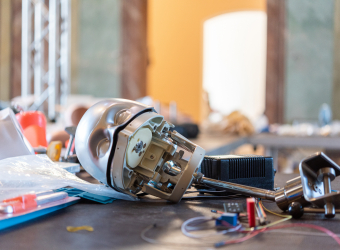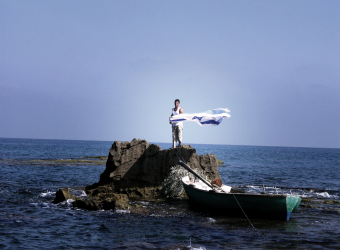Fondazione Modena Arti Visive is pleased to announce the reopening of Upgrade in Progress, the first solo show by Korean artist Geumhyung Jeong in an Italian contemporary art institution, which had opened on 6 March but had to be closed to the public just two days later owing to the health emergency. As of Monday 18 May, the Palazzina dei Giardini will again be opening its doors to visitors, so that in person they will finally be able to observe the astounding, original mechanical sculptures on display, which had already attracted the attention of the Italian and international press during the lockdown.
The exhibition, curated by Diana Baldon, presents a new site-specific installation commissioned by Fondazione Modena Arti Visive, centred around Geumhyung Jeong’s most recent project. The artist has distinguished herself in the international field of the performing arts for her amusing and sinister choreographies in which she performs with electrical appliances with a humanoid appearance. Mixing a variety of media – dance, theatre, filmmaking and sculpture – her works deploy a range of prosthetic devices, mechanical and tech hardware tools, cosmetics and medical dummies, involving live performances in which she “demonstrates”’ how her objects can be used. When presented in visual arts contexts, she sets out the objects in bizarre sequences, orderly arranged on pedestals situated in intense white light settings that mock scientific archives and museum collections.
Upgrade in Progress is the further development of Homemade RC Toy, a series of remote-controlled mechanical sculptures conceived in 2019 for her exhibition at Kunsthalle Basel, and of Small Upgrade presented the same year at the 5th Ural Industrial Biennial of Contemporary Art (Russia). Jeong’s “robots” are disarmingly amateurish, due to their DIY construction with components outsourced from specialist websites. Moreover, because the artist is self-taught in the principles of software programming and mechanics, the robots act in an unpredictable, clumsy manner owing to the limited range of motion with which they have been alchemically imbued.
As the exhibition title suggests, this new group of works is the follow-on of an allegorical narrative begun last year. These remote-controlled mechanical robots have been built with similar visual and structural features to the previous “models” but possess a wider range of movements imposed by a design that not only gains in agility, but also controls the uncanny and inane appearance of some parts of their bodies. The sculptures are placed over modular worktables that transform the rooms of the Palazzina dei Giardini into a total stage setting. Thanks to this spatial environment, the artist’s work in performing tests and experiments on her own “toys” is not merely represented, as the activity is transferred onto a series of videos dispersed throughout the gallery spaces.
Geumhyung Jeong. Upgrade in Progress
Upgrade in Progress, the first solo show for Geumhyung Jeong in an Italian contemporary art institution, presents a new site-specific installation commissioned by Fondazione Modena Arti Visive and centred around the Korean artist’s most recent project
Address
FMAV - Palazzina dei Giardini:Corso Cavour, 2, 41121 Modena
Opening times
Fino al 28 giugno
Mercoledì, giovedì e venerdì: 11-13 / 16-19; sabato, domenica e festivi: 11-19
Dal 2 luglio
Da giovedì a domenica 17-22.
Entry
LIBERO
Ogni sabato alle ore 18 Visita guidata gratuita
Information
Guarda il trailer della mostra realizzato dall'artista QUI
Ascolta le tracce dell'audioguida QUI
+39 059 2032919
biglietteria@fmav.org
Press office
Ufficio stampa FONDAZIONE MODENA ARTI VISIVE
Irene Guzman | T. +39 349 1250956 | Email i.guzman@fmav.org

























